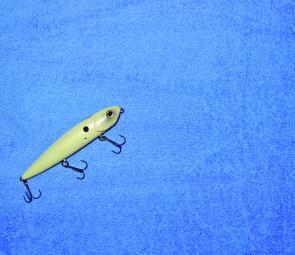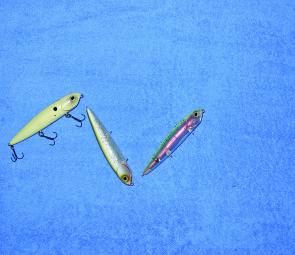The luring technique known as ‘walking the dog’ refers to the retrieve cadence that generates the unique gliding, side to side, zigzag action normally associated with cylindrical-shaped surface stickbaits. The stickbait is a lure with which the angler has a large part to play in the action that appears out there in front of the fish. A stickbait can be fished super slow, or you can dial it up and crank it fast.
My take on the walk the dog technique is that it causes maximum movement and disturbance on the water’s surface without moving the lure as far forward as other techniques. In this way the lure stays in the strike zone for longer, but still calls fish in from afar. Because the lure moves sideways and then back again, rather than forwards, then when a fish is called in from over yonder, the lure is still there when the hungry predator arrives.
There are three types of stickbait:
1/ those with a curved belly;
2/ those that sit flat in the water;
3/ the ones that hang tail-down.
All three variants can be used with the walk the dog technique. My suggestion is that you should have all three in your tackle box, however you’ll find that the lures that lay flat in the water give you the most flexible retrieve options.
Lures that float flat at rest are more likely to glide out to each side at 90 degrees to the line. In fact, if you flick the rod tip back towards the lure after the ‘twitch’, then you can give the lure enough slack line to turn back at an angle greater than 90 degrees. Masters of the art can sit these well balanced lures in the one spot and walk them from side to side without touching the reel handle. As a party trick they’ll do it with one hand behind their back.
Tail heavy lures don’t turn out away from the main line as much; therefore they are suited to faster, more constant retrieves.
To set yourself up for success, start with the lure. Firstly tune your lure(s) to sit flat in the water. Accordingly, if you are upgrading trebles to heavier ‘barra’ grade hooks, then select a very buoyant lure and study how it reacts as you load it up. You may choose to run only two hooks on a lure that has three hook hangers in order to keep the extra weight to a minimum.
Keep in mind that lures will be more buoyant in salt water.
A snap swivel may balance out the lure or it may cause it to be nose heavy and cause it to dive under water (especially in freshwater) rather than glide on the surface. Most aficionados prefer loop knots.
Too heavy a leader will restrict the action of your lure. For barramundi and other fish that often demand a heavy and durable leader then choose a lure that can handle it. Lighter leaders generally allow smaller lures to glide better. Ideally the line that you use will float on the surface. For most Australian fishing situations, this means using braid as your mainline and running a length of mono type line (floating line) as a leader. The generally accepted ideal leader length in today’s casting orientated fishing is a leader that is just shorter than the distance from the reel to the rod tip. Such a leader length negates any issues with leader knots getting caught either on the reel’s spool or line guide.
Rod length is not so critical to the lure’s final action. Some techniques call for long rods (to give increased casting distance for example) and the walk the dog action will be imparted to the lure by either working the rod tip to the side of the angler’s body or with the tip up in the air at about 45 degrees. Other scenarios see the angler using a short rod and pointing the rod tip down as part of the walk the dog retrieve technique.
Repetitive short twitches with the rod tip, imparted with a little bit of slack in the line (between the rod tip and the lure), is the rhythm that will get your lure walking the dog. It does take a bit of practice.
Some schools of thought recommend that you watch your lure and study how it relates to your wrist action, others say to ignore the lure and watch your wrist. I think a little experimentation with both philosophies will get you analysing different aspects and you’ll soon pick it all up and put the jigsaw puzzle together. Then you can start working on my favourite trick, which is to practice it with left-hand wind reels (right hand on the rod) and then right-hand wind reels (left-hand on the rod). This swapping of hands really reinforces your understanding of the good and bad things that you can do to tweak (or destroy) your lure’s reactions.
The idea is to get the lure darting from side to side. This is achieved with small rod tip movements. After casting the lure out and letting it settle, impart some slack in the line between the lure and the rod tip and then twitch the rod tip. This will start the lure travelling forward. Then drop the rod tip back to the lure to give some slack in the line again and the lure will now start to turn sideways and glide out and off to the side. The lure is now (hopefully) pointing away from the axis of retrieve.
When the slack forms in the line, (you may impart some of this yourself by moving the rod tip slightly towards the line and therefore the lure) you'll feel the reduction in tension, and that's when you twitch again. This time the lure’s nose will be jerked back in the other direction and the same rod and line control (to impart some lack in the line) will see the lure glide back at 180 degrees ‘side to side’. Each subsequent stab of the rod tip should be done on a slack line.
The length of each line pull, along with the cadence rate, will determine the distance that the lure travels to the side on each glide. A lot of commentary focuses on the movement of the rod tip, however the real deal is to focus on what the line is doing and therefore the rod tip’s influence on the line.
It may take a bit of practice to make each pull equal distance. However, don’t forget how to make your lure walk (glide) in one-direction only. Giving one long pull followed by one quick stab, short twitch, another long stab, a short twitch cadence, etc…or even long stabs with neutralising repositioning in-between will enable you to walk the lure in an arc or into a piece of structure that is off to the side.
If there is either some current flow or even a steady breeze, set yourself (and/or your boat) in position so that you retrieve the lure into the current and into/across the target zone. The forces of nature will hopefully drag the lure back and allow you keep your lure in the strike zone for longer. In this situation it is important to watch how the lure reacts to the snaps of your wrist and the movement of the rod tip. You may need to offer more slack in your line and this can be achieved by dropping the rod tip back towards the lure before you twitch the rod tip to glide the lure.
Study the reaction of the fish to your lure. Some species will like it hot, skipping across the water at speed, others will respond best to a long pause after each glide to the side. Relate the target fish’s likes and dislikes (it is possible to target more than one species at different stages of the retrieve) in comparison to the various strike zones that the lure will encounter across the full length of its retrieve path. Then mix and match as you work the lure back to you. For example you may employ a steady or even a fast cadence across an open sand flat but then slow down and pause (or twitch) on the spot when your lure gets close to or beside a snag. This way you’ve targeted active fish like trevally in the open and then focused on seducing an ambush feeder adjacent to the structure…all in the one retrieve.
Rod tip up or down? Your choice depends on the variables of the situation that you find yourself in. Walking the bank with a cross current for example might see you using a tip-up angle to your rod in order to keep line out of the water and your rod tip away from tangling vegetation.
Standing on the deck of a bass boat with everything ‘perfect’ will on the other hand lend itself to a tip-down rod angle.
Stickbait users can try a steady and constant retrieve which jumps across the surface of the water or the popular ‘walk the dog’ technique will have the lure moving consistently from side-to-side across the water.
Stop reeling and wait a few seconds every once in a while. Begin reeling again with the same motion and rhythm. When you begin reeling, be prepared for a strike; fish often go for the bait once it starts moving again.
Walking the dog with stickbaits is a deadly technique on a number of Aussie fish. From giant GT through to the delicate whiting, walking the dog is definitely a technique you need in your arsenal.
Reads: 13404
Walking the dog starts just after the lure hits the water

With a little slack in the line the lure is jerked and it will turn and glide across the 'axis of retrieve'

Do the same again and the lure will walk to the opposite side

Maintain the cadence of the lure all the way back to your rod tip and you are walking the dog. (incidentally I've had fish pluck my lure out of my tip guide, so it can pay to focus all the way)

Mangrove jack love dog walked stickbaits and smash them hard. This feisty jack came from the Tully River on a Lucky Craft Sammy.

Barra are a classic walk the dog target. They often hover underneath a paused stickbait before smashing it as soon as you start walking the dog again. This barra was caught on a C’ultiva Tango Dancer fished in a billabong at Lakefield National Park.

Aussie bass smash stickbaits and this one slammed a Lucky Craft Sammy in an urban waterway in Brisbane’s southern suburbs. You just never know what you’ll find in waterways these days!




